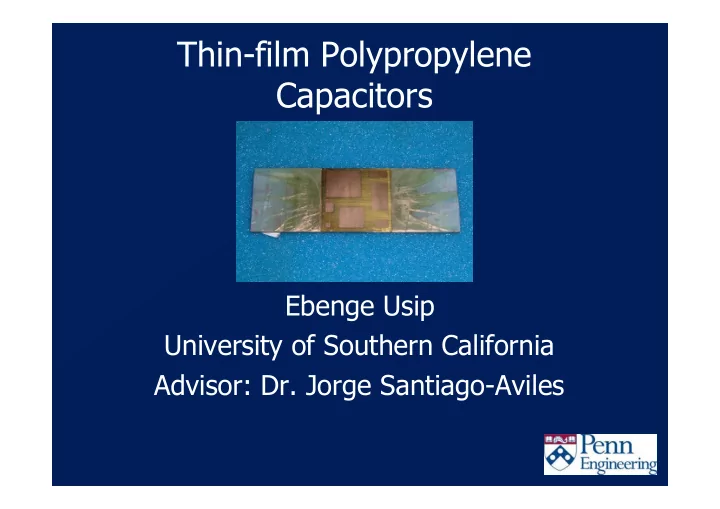

Thin-film Polypropylene Capacitors Ebenge Usip University of Southern California Advisor: Dr. Jorge Santiago-Aviles
The Capacitor � Consist of a dielectric material sandwiched between two metal electrodes � Several types of capacitors: -Electrolytic -Ceramic -Electrochemical (supercapacitors) � Properties of a parallel-plate capacitor are governed by: C= *A/d , E=1/2*C*V 2 , Q=V*C
Series Capacitance When connected in series n number of capacitors have an equivalent capacitance of: 1/C 1 +1/C 2 + 1/C 3 = 1/C equiv
Porphyrins � Natural pigments which consist of four pyrrole subunits linked via four methine bridges � The properties of free base porphyrins can be manipulated by adding metal ions to the center of their structures
Potential Applications � Electric vehicles � Medical instrumentation � Aviation and aerospace vehicles � Military � High voltage industrial processes
The Dielectric Compound � An organic polymer called polypropylene � Relatively cheap to produce � Breakdowns at a high voltage of 640 V/µm � Can operate at high temperatures � Highly Polarizable � Commercially Available
Testing Process � Measurement of the capacitance of polypropylene dielectrics � Thickness was an important variable as it is indirectly proportional to capacitance - C= Є *A/d � A film of doped polypropylene was spin-cast on a gold- plated microscope slide � A thin layer of gold was vapor-deposited onto the film to complete the capacitor
Problems & Solutions � Increasing the capacitance of polypropylene � Polypropylene was doped with various porphyrins to see if such additives increased capacitance � The polypropylene film was initially too thin, making the capacitance too large for the capacitance bridge C= *A/d � As a result three layers had to be deposited in order to increase thickness
Problems & Solutions � Accurate measurement of the film thickness was also difficult � An ellipsometer was used but it could not evaluate the film’s thickness with enough precision
Final Results .03516 cm. ^2 -100 Hz 14000 12000 Capacitance (microfarads) 10000 8000 6000 R 2 = 0.966 4000 2000 0 0 5 10 15 20 Doping Level (% by weight)
Final Results .1057 cm. ^2 -100 Hz 9000 8000 Capacitance (microfarads) 7000 6000 5000 4000 R 2 = 0.7686 3000 2000 1000 0 0 5 10 15 20 Doping Level (% by weight)
Final Results 1.43 cm. ^2 -100 Hz 10000 9000 8000 Capacitance (microfarads) 7000 6000 5000 4000 R 2 = 0.9588 3000 2000 1000 0 0 5 10 15 20 Doping Level (% by weight)
Initial Results Zn 3,5 25000 20000 (microfarads) Capacitance 15000 R 2 = 0.1519 10000 5000 0 0 0.5 1 1.5 2 Area (cm. ^2)
Initial Results Zn 3,5 10V Bias 25000 20000 (microfarads) Capacitance 15000 R 2 = 0.2504 10000 5000 0 0 0.5 1 1.5 2 Area (cm.^2)
Conclusion � Porphyrins have been found to be an effective additive for increasing the capacitance of polypropylene and with further research could definitely be placed into future applications
Acknowledgements � Sincere thanks to the Electrical and Systems Engineering Department, advisor Dr. Jorge Santiago, and doctoral student Paul Frail of Dr. Michael Therien’s research group in the Chemistry Department
Recommend
More recommend